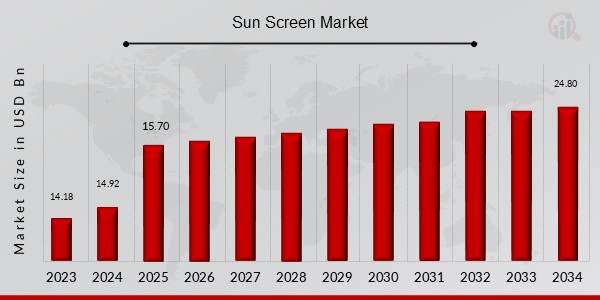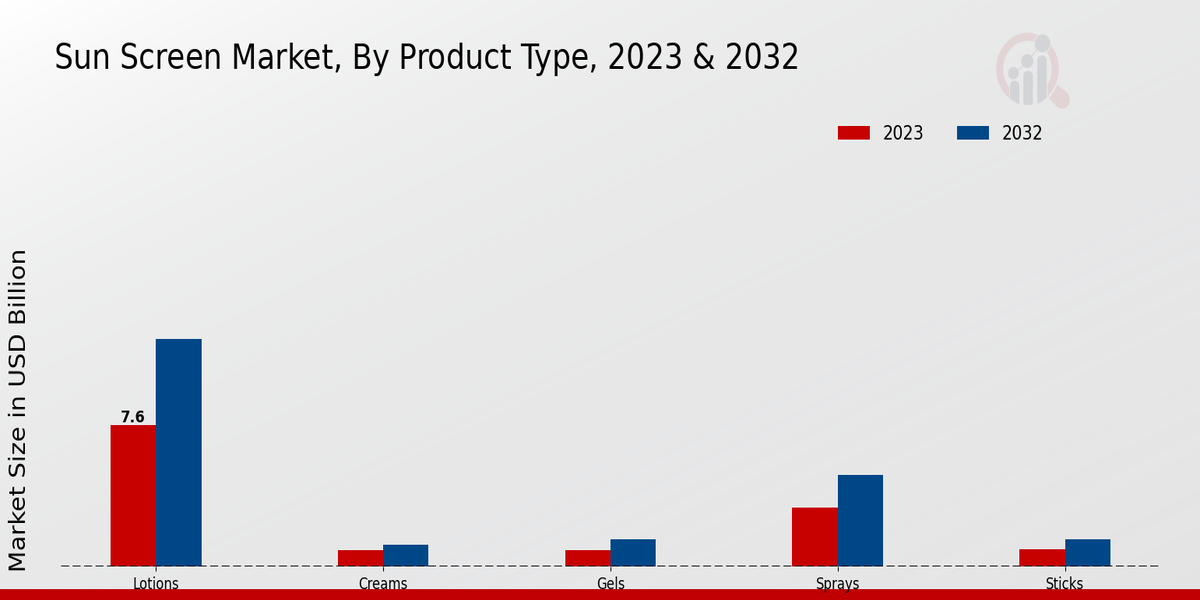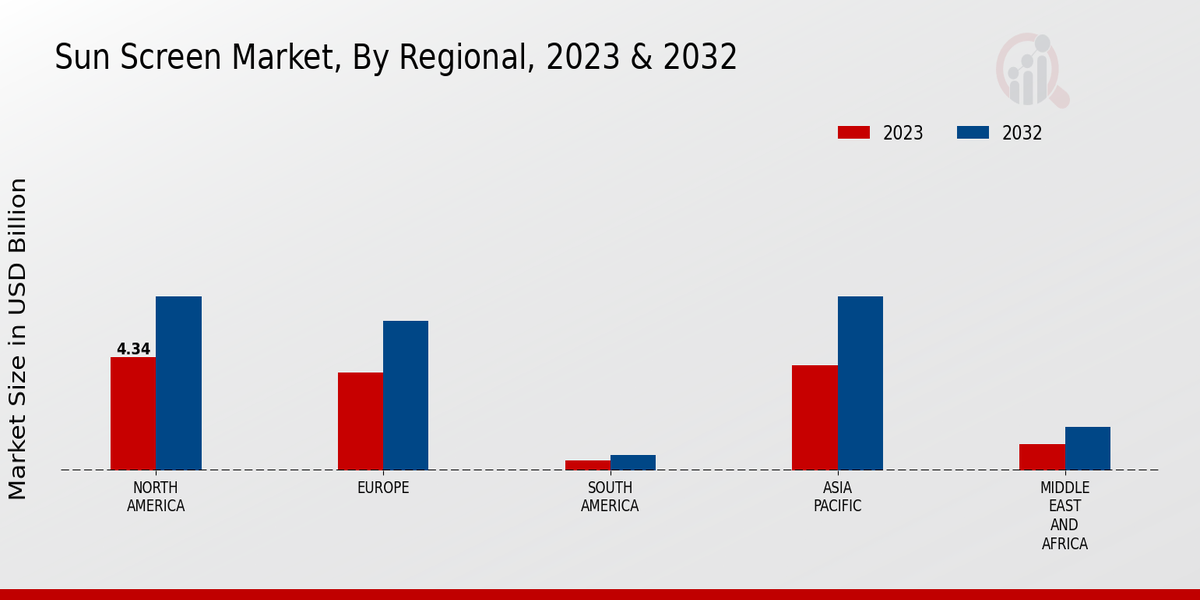Global Sun Screen Market Overview
Sun Screen Market Size was estimated at 14.92 (USD Billion) in 2024. The Sun Screen Market is expected to grow from 15.70 (USD Billion) in 2025 to 24.80 (USD Billion) by 2034. The Sun Screen Market CAGR (growth rate) is expected to be around 5.2% during the forecast period (2025 - 2034).

Source Primary Research, Secondary Research, MRFR Database and Analyst Review
Key Sun Screen Market Trends Highlighted
Key market drivers
The sunscreen market is primarily driven by rising skin cancer awareness, increasing intensity of UV rays, and increasing outdoor pursuits. In turn, high availability and higher disposable incomes have forced an increase in demand for natural and organic sunscreens.
Opportunities to be explored or captured
There are considerable possibilities for growth in the sunscreen market, particularly in the emerging regions. As their disposable income rises and health awareness increases, it is likely that consumers in these areas will purchase sun protection products. Furthermore, the introduction of new and improved sunscreen varieties, such as ones that have anti-aging or moisturizing properties, presents exciting prospects.
Trends in recent times
Much change has occurred in the sunscreen market due to the rise in the trend of buying products over the Internet. Consumers are now buying sunscreen products through e-commerce because of the ease and diversity of products. Also, there is a gradual increase in the demand for sunscreens that have dual functions of protecting the skin and caring for the skin.
Sun Screen Market Drivers
Rising Skin Cancer Awareness
Skin cancer is the most rapidly increasing type of cancer worldwide. According to the World Health Organization, one in three people will develop some form of skin cancer in their lifetime. This rising prevalence and associated awareness propels the growth of broad-spectrum sunscreens, which are designed to protect from UVA and UVB radiation.
Growing Demand for Natural and Organic Sunscreens
Consumers are increasingly seeking out natural and organic products, including sunscreens. This is due to concerns about the potential health risks associated with synthetic ingredients in conventional sunscreens. Natural and organic sunscreens are made with ingredients derived from plants and minerals, which are considered to be gentler on the skin and the environment.
Expansion into Emerging Markets
The sunscreens market is expected to grow significantly in emerging markets in the coming years. This is due to rising disposable incomes, increasing awareness about the importance of sun protection, and growing populations in these regions. Manufacturers are focusing on expanding their distribution channels and product offerings in emerging markets to capitalize on this growth opportunity.
Sun Screen Market Segment Insights
Sun Screen Market Product Type Insights
Product types of the Sun Screen Market include lotions, creams, gels, sprays, sticks, and others. The information demonstrates that the main market share is held by lotions primarily for their ease of use and the overall ability to provide the broadest protection against UVA and UVB rays. A similar product type that gained popularity among people with sensitive skin is creams since they are thicker and moisturize the skin to a greater extent. Gels, however, started to be used more often, which is due to their lightweight and no-grease formula and overall quick application.
The sprays can protect the entire back or legs as all the products provide even coverage. The sticks are more portable and can be applied easily when the remaining lotion in the stick dries out. The other product types, such as powders, serums, and wipes, all have their specific uses and are more beneficial for certain consumers. The Sun Sunscreen market seems to grow soon, as there is an increased number of people who are aware of UV radiation and its harm, as well as the increased number of activities and disposable income in emerging markets.

Source Primary Research, Secondary Research, MRFR Database and Analyst Review
Sun Screen Market Broad Spectrum Coverage Insights
Over the forecast timeline, it is expected that the Broad Spectrum Coverage segment will grow considerably, with the expansion being credited to the increased awareness regarding the deleterious effects of UVA and UVB rays on the skin. UVA rays – with a higher wavelength than that of UVB rays – can get into the skin and cause signs of aging, including but not limited to wrinkles. By contrast, UC rays cause sunburns and skin cancer. Broad-spectrum sunblock offers protection against both types of rays and, thus, is indispensable when dealing with the menace of skin burns and cancers.
As a result, the Sun Screen Market revenue for 2023 for UVA/UVB is expected to reach $13.48 Billion and, by the end of 2032, $21.3 Billion with a 5.21 % CAGR. The UVA Only segment will reach $3.2 Billion in 2023 and at a CAGR of 4.8 %, while the UVB Only segment is expected to increase by 4.5 % by 2032 and reach $2.9 Billion by 2032. The key driving factors for the current growth of the broad-spectrum screen include both the predetermined increase in the incidence of skin cancer and other sunburns and the associated skin issues, exposure of which is a considerable risk factor in developing melanoma.
According to the World Health Organization, skin cancer is one of the most common types of skin cancer, especially among the Caucasian population. With the significant risk of exposure to sun rays and the likely development of skin cancer, the overall demand for broad-spectrum sunscreens is likely to increase exponentially.
Sun Screen Market SPF Range Insights
The SPF Range segment plays a crucial role in the Sun Screen Market, influencing consumer preferences and product demand. Among the key SPF ranges, '30-50' holds a significant market share, driven by its ability to provide balanced protection against UVA and UVB rays without feeling heavy or greasy on the skin. The '15-30' SPF range caters to individuals seeking moderate sun protection, while the '50+' SPF range is preferred by those requiring maximum protection from intense sun exposure. Furthermore, the Sun Screen Market data indicates a growing demand for '0-15' SPF products, particularly in regions with lower UV radiation levels.
This segment is expected to witness steady growth as consumers become more aware of the importance of daily sun protection. Overall, the SPF Range segmentation offers valuable insights into consumer preferences and market trends, enabling manufacturers to tailor their products to meet specific market demands.
Sun Screen Market Water Resistance Insights
The Water Resistance segment of the Sun Screen Market is segmented into 'Not Water Resistant', 'Water Resistant (40-80 minutes)', and 'Very Water Resistant (80+ minutes)'. In 2023, the 'Water Resistant (40-80 minutes)' segment held the largest market share, accounting for approximately 45% of the market revenue. The 'Very Water Resistant (80+ minutes)' segment is expected to register the highest CAGR of 6.2% during the forecast period (2024-2032). The growth of this segment can be attributed to the increasing awareness about the importance of protecting the skin from harmful UV rays, even during water activities.
Sun Screen Market Application Form Insights
The Sun Screen Market industry is segmented into Roll-On, Pump, Tube, Aerosol. The Roll-On segment held the largest market share in 2023, accounting for 35.4% of the Sun Screen Market revenue. The Pump segment is expected to register the highest CAGR of 6.2% during the forecast period. Roll-On sunscreens are convenient and easy to apply, making them a popular choice for consumers. Pump sunscreens are also easy to use and provide good coverage. Tube sunscreens are a good option for people who want to control the amount of sunscreen they apply.
Aerosol sunscreens are convenient and can be applied quickly, but they can be more expensive than other types of sunscreens. The increasing awareness of the importance of sun protection is driving the growth of the Sun Screen Market. Consumers are becoming more aware of the harmful effects of UV radiation, and they are looking for effective ways to protect their skin. Sunscreens are an effective way to protect the skin from UV radiation, and they are becoming increasingly popular among consumers. The growing demand for sunscreens is expected to continue to drive the growth of the Sun Screen Market in the coming years.
Sun Screen Market Regional Insights
The market is segmented into various regions, such as North America, Europe, APAC, South America, and MEA. North America is expected to hold the largest share of the Sun Screen Market in 2023 and is projected to continue its dominance throughout the forecast period. The growth in the region can be attributed to the increasing awareness about the harmful effects of UV radiation and the rising demand for sun protection products. Europe is another major region in the Sun Screen Market and is expected to witness steady growth in the coming years.
The market in Europe is driven by the growing popularity of outdoor activities and the increasing demand for sun protection products among consumers. APAC is expected to be the fastest-growing region in the Sun Screen Market from 2024 to 2032. The growth in the region is attributed to the increasing disposable income, rising awareness about sun protection, and growing demand for skincare products. South America and MEA are expected to witness moderate growth in the Sun Screen Market during the forecast period. The growing awareness about sun protection and the rising demand for sun protection products in these regions will drive the market growth.

Source Primary Research, Secondary Research, MRFR Database and Analyst Review
Sun Screen Market Key Players And Competitive Insights
The constant ambition of the major players in the Sun Screen Market industry to stay ahead of the competition is achieved through investment in innovative products and the broadening of the distribution network. Leading Sun Screen Market players pour enormous investments in research and development to deliver an optimum solution for the constantly changing consumer needs. The Sun Screen Market is fierce, and competition among the players takes many forms, including new product launches, strategic partnerships, and aggressive marketing strategies to increase market share. The Sun Screen Market is witnessing a significant boost due to rising consumer awareness regarding the harmful effects of sun exposure. Moreover, some of the other factors fueling the Sun Screen Market include the rise of disposable income standards and the rise in demand for natural and organic products.
Shiseido Company, Limited is a typical player in the Sun Screen Market. Shiseido is a leading brand producing innovative skincare and cosmetics products. The company’s sunscreen product offering is transcontinental and delivers products for most types of skin. The company focuses on maximizing the consumer experience while providing an effective and premium product. The use of advanced technologies in the product assures the consumer maximum pleasure and satisfaction.
L’Oréal S.A. is another example of a major player in the Sun Screen Market. The company offers a wide variety of sunscreens. Among the most important are sunscreens produced by La Roche-Posay, Vichy, and Garnier. L’Oréal aims to provide all potential consumers with affordable and easily accessible solutions with broad-spectrum protection with UVA and UVB filters. The products are dedicated to all major skin types, including normal as well as sensitive and acne-prone skin. L’Oréal’s strength is in its superior distribution network and brand recognition, which are key success factors in the Sun Screen Market.
Key Companies in the Sun Screen Market Include
-
Beiersdorf
-
Kao Corporation
-
LVMH
-
L'Oréal
-
Estée Lauder
-
Johnson Johnson
-
Shiseido
-
Revlon
-
Avon Products
-
Coty
-
Unilever
Sun Screen Market Industry Developments
The Sun Screen Market is projected to reach a valuation of USD 21.3 billion by 2032, expanding at a CAGR of 5.21% from 2024 to 2032. Rising consumer awareness about the harmful effects of UV radiation and increasing prevalence of skin cancer are key factors driving market growth. Additionally, growing demand for natural and organic sunscreens, and the introduction of innovative products with advanced formulations are contributing to market expansion. Recent developments include the launch of sunscreens with enhanced protection against blue light and infrared radiation, as well as the development of sunscreens specifically tailored for sensitive skin and children. Key players in the market are investing in research and development to introduce new products and strengthen their market position.
Sun Screen Market Segmentation Insights
Sun Screen Market Product Type Outlook
- Lotions
- Creams
- Gels
- Sprays
- Sticks
- Others
Sun Screen Market Broad Spectrum Coverage Outlook
- UVA Only
- UVB Only
- UVA/UVB
Sun Screen Market SPF Range Outlook
Sun Screen Market Water Resistance Outlook
- Not Water Resistant
- Water Resistant (40-80 minutes)
- Very Water Resistant (80+ minutes)
Sun Screen Market Application Form Outlook
- Roll-On
- Pump
- Tube
- Aerosol
Sun Screen Market Regional Outlook
- North America
- Europe
- South America
- Asia Pacific
- Middle East and Africa
| Report Attribute/Metric |
Details |
| Market Size 2024 |
14.92(USD Billion) |
| Market Size 2025 |
15.70(USD Billion) |
| Market Size 2033 |
24.80(USD Billion) |
| Compound Annual Growth Rate (CAGR) |
5.2% (2025 - 2034) |
| Report Coverage |
Revenue Forecast, Competitive Landscape, Growth Factors, and Trends |
| Base Year |
2024 |
| Market Forecast Period |
2025 - 2034 |
| Historical Data |
2021 - 2025 |
| Market Forecast Units |
USD Billion |
| Key Companies Profiled |
Beiersdorf, Kao Corporation, LVMH, L'Oréal, Estée Lauder, Johnson Johnson, Shiseido, Revlon, Avon Products, Coty, Unilever |
| Segments Covered |
Product Type, Broad Spectrum Coverage, SPF Range, Water Resistance, Application Form, Regional |
| Key Market Opportunities |
Increase in skincare awareness demand for natural and organic products rising disposable income urbanization in developing countries Growing popularity of ecommerce |
| Key Market Dynamics |
Rising demand for sunscreens, growing awareness of skin cancer, increasing disposable income, expanding ecommerce channels, technological advancements |
| Countries Covered |
North America, Europe, APAC, South America, MEA |
Frequently Asked Questions (FAQ) :
The sun screen market is expected to reach a valuation of 15.70 billion US dollars in 2025. By 2034, the market is projected to reach a value of 24.80 billion US dollars, exhibiting a compound annual growth rate (CAGR) of 5.2% between 2025 and 2034.
The Asia-Pacific region is anticipated to hold a dominant position in the sun screen market throughout the forecast period. Factors such as increasing disposable income, growing awareness about skincare, and a large consumer base in countries such as China and India are driving the growth in this region.
Sunscreens find extensive use in various applications, including beach and outdoor activities, daily skincare routines, and sports and recreational activities. They are formulated to protect the skin from the harmful effects of ultraviolet (UV) radiation from the sun, preventing sunburns, premature aging, and skin cancer.
Key players in the sun screen market include L'Oréal, Beiersdorf, Johnson Johnson, Unilever, Shiseido, and Procter Gamble. These companies offer a wide range of sunscreens tailored to meet the diverse needs of consumers, including products with varying sun protection factors (SPF), formulations, and application methods.
Growing awareness about the harmful effects of UV radiation and increasing incidence of skin cancer are major factors driving the growth of the sun screen market. Additionally, rising disposable income, changing lifestyles, and the popularity of outdoor activities are contributing to the demand for sunscreens.
The sun screen market faces certain challenges, including stringent regulatory requirements, intense competition from both established and emerging players, and the development of alternative sun protection methods such as UV-protective clothing and accessories.
Key trends shaping the sun screen market include the growing adoption of broad-spectrum sunscreens that protect against both UVA and UVB rays, increasing demand for natural and organic sunscreens, and the emergence of personalized sunscreens tailored to specific skin types and needs.
The COVID-19 pandemic had a mixed impact on the sun screen market. While lockdowns and restrictions on outdoor activities led to a decline in demand, increased awareness about hygiene and personal care during the pandemic also contributed to growth in the market.
The future outlook for the sun screen market remains positive. Rising consumer awareness about skin health, increasing disposable income, and growing popularity of outdoor activities are expected to drive growth in the market. Additionally, advancements in sunscreen technology and the development of innovative products are likely to further contribute to market expansion.
Emerging trends in the sun screen market include the growing popularity of sunscreens with high SPF values, the increasing demand for sunscreens specifically designed for sensitive skin, and the emergence of sunscreens with added skincare benefits such as anti-aging and moisturizing properties.

















